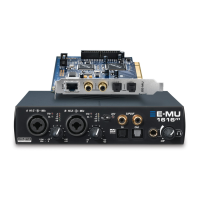4 - The PatchMix DSP Mixer
Mixer Strip Creation
36 Creative Professional
Mixer Strip Creation
f Adding or deleting a
strip “defragments” the
effect/DSP resources. If
you have used all your
effects and need another,
try deleting an unused
strip.
PatchMix DSP is a dynamically configurable mixer. Each mixer session can contain an
arbitrary number of strips up to a limit set by the number of available input sources and
available DSP resources.
You must create a strip for each mono or stereo audio input, and for each ASIO stream
you wish to use in your software application. This is important because outputs will not
appear in your software application until you have created ASIO strips in PatchMix.
• Host refers to a computer application such as Cubase.
• Physical refers to hardware input or output such as a output jack.
To Add a New Strip:
1. Click on the “New Mixer Strip” button. See Overview of the Mixer
2. The New Mixer Strip Input Dialog appears:
f CDs & MP3s: The
WAVE 1/2 strip is used
to playback CDs,
Windows Media Player,
and Direct Sound.
3.
Select the desired input to the mixer strip from the following choices:
Physical
Sources
ASIO
Sources
• Physical Source: Analog or digital input (Analog, ADAT, S/PDIF)
• Host - ASIO Source input Streaming audio from an ASIO software application.
• Host - WAVE input Window sound sources — WAVE, WDM, CD
Mixer Strip Type Function
Physical: I/O Card In 24-bit mono or stereo analog input from the 0202 Daughter Card.
Physical: Dock Mic/Line 24-bit mono or stereo analog input from the AudioDock.
Physical: Dock In 24-bit mono or stereo analog input from the AudioDock.
Physical: PCI Card S/PDIF 2 channel digital audio from the S/PDIF input on the E-MU 1010 card.
Physical: PCI Card ADAT 2 channel digital audio from the ADAT input on the E-MU 1010 card
HOST SOURCE Function
Host ASIO Output Source
From software application
Mono or stereo digital audio from an ASIO source (recording or
software app). ASIO: 1/2, 3/4, 5/6, 7/8, 9/10, 11/12, 13/14 … 31/32

